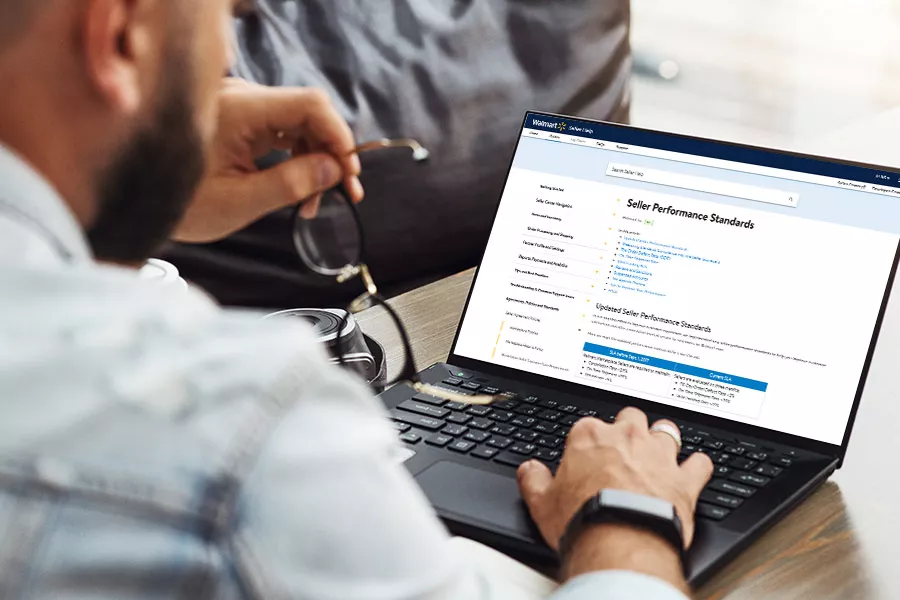Categories
Latest Posts
Tags
Advertising Amazon Amazon Advertising Amazon Experts Amazon Listing Optimization Amazon Marketplace Amazon News Amazon Prime Amazon Professional Sellers Summit Amazon Seller amazon sellers Amazon Seller Tips Amazon Seller Tools ASIN Brand Management Brands Buy Box Campaign Manager Conference COVID-19 downloadable Dynamic Pricing Ecommerce FBA FBM Holiday Season industry news Multi-Channel Fulfillment Optimize pay-per-click Pricing Algorithm Pricing Software Private Label Profits Repricing Repricing Software Revenue Sales Seller Seller-Fulfilled Prime Seller Performance Metrics SEO SKU Sponsored Products Ads Strategy
Get the latest insights right in your inbox

Walmart Seller Performance Standards
In order to maintain customer satisfaction and remain in good standings with Walmart, you must adhere to specific seller performance standards on the marketplace. You are evaluated on the following metrics, each of which will be explained in detail below:
- 90-day order defect rate <2%
- On-time shipment rate >99%
- Valid tracking rate >99%
Although there are similar performance metrics on the Amazon marketplace, the compliance thresholds and definitions of each metric are different. The metrics are captured and updated biweekly in your Seller Scorecard, which is located in Seller Center under “Analytics.”
In addition to your performance, you can reference your Seller Scorecard for ratings and reviews you receive from Walmart Marketplace customers on a cumulative basis. After an order is received, customers receive an email to review their items and the seller who shipped the items. However, customers are not required to leave comments — if they leave it blank, the review will show “No comments left.”
Once left, reviews appear to other shoppers on each seller’s Partner Profile page. You have the ability to sort individual ratings or comments by newest to oldest, oldest to newest, highest to lowest, or lowest to highest so you can hone in on the most relevant reviews. Overall, the Seller Scorecard is utilized to highlight key metrics so you can more effectively monitor your performance and maintain buyer trust.
Order Defect Rate
The order defect rate is the number of orders with a defect divided by your total number of orders in the same time period. On your Seller Scorecard, the 90-day order defect rate is calculated from 120 days ago to 30 days ago so that orders still within the return window are not calculated in your rate. Order defect rate can be calculated over any historical order period, but it will be shown for a 14-day and 90-day period — both of which are updated on the first and 15th of every month.
Order defects can include cancellations, returns, delivery defects, or customer complaints. Cancellation defects are orders that you as the seller cancelled after receiving the order from Walmart. Delivery defects include orders that were delivered after the expected delivery date; customer complaints are for orders where customers contacted Walmart or the seller directly indicating their dissatisfaction; and return defects indicate there was a problem with the delivered product.
Multiple issues on the same order are combined into a single defect for order defect rate calculation. If your order defect rate is between 2% and 6%, Walmart recommends directly addressing the metrics that are causing the defects. If it surpasses 6%, you should work to address the metrics in order to avoid account suspension.
If you have 50 or more transactions over the last 120 days, you are evaluated based on the last three months. However, if you have less than 50 transactions and more than 120 days selling on the platform, you are evaluated on the past 12-month period. Walmart’s Partner Performance team regularly monitors seller performance, particularly those who do not comply with the order defect rate standard, and will notify you if you are not compliant.

Increase Your Walmart Profits with Feedvisor
Did you know we offer price and advertising optimization fueled by the most accurate AI data?
On-Time Shipment Rate
On-time shipment rate is the percentage of orders that shipped — or received shipping confirmation — on or by the expected ship date. You are required to provide Walmart with an order shipping confirmation and valid tracking information. Once Walmart receives this, it will notify the customer.
Valid Tracking Rate
Valid tracking rate is the percentage of orders with valid tracking information and delivery scan provided on or before the expected delivery date. Large and bulky items that are sent through regular shipping methods (Value, Standard, Expedited, or Next Day) are subject to regular shipping rules. You should provide a URL that allows your customers to track shipments. If this is not possible, you need to provide the URL of the website on which the customer can track the order themselves.
If at any time your performance dips below the pre-established thresholds, your account may be temporarily suspended or blocked. Before Walmart takes any action, you will receive at least one warning and you will not face potential suspension until your marketplace account has been live for 120 days.
Tips From Walmart to Optimize Seller Performance
- Provide accurate tracking and carrier information for all of your Walmart Marketplace orders.
- Add a valid customer service phone number, email address, and business hours to Seller Center.
- Make sure your product descriptions are accurate, up to date, and easy to understand.
- Avoid product damage by packing your orders carefully.
- Ship and deliver your orders on time by ensuring orders are shipped by the estimated ship date and delivered by the estimated delivery date.
- Regularly review your Seller Scorecard so you are familiar with your metrics.
- Provide “always on” support by making your company or team available to respond to customer inquiries within 24 hours, seven days a week.
- Keep the customer front of mind during all shopping experiences, particularly refunds, cancellations, and customer-driven inquiries. Be patient and avoid using aggressive or unpleasant language when dealing with customers.


